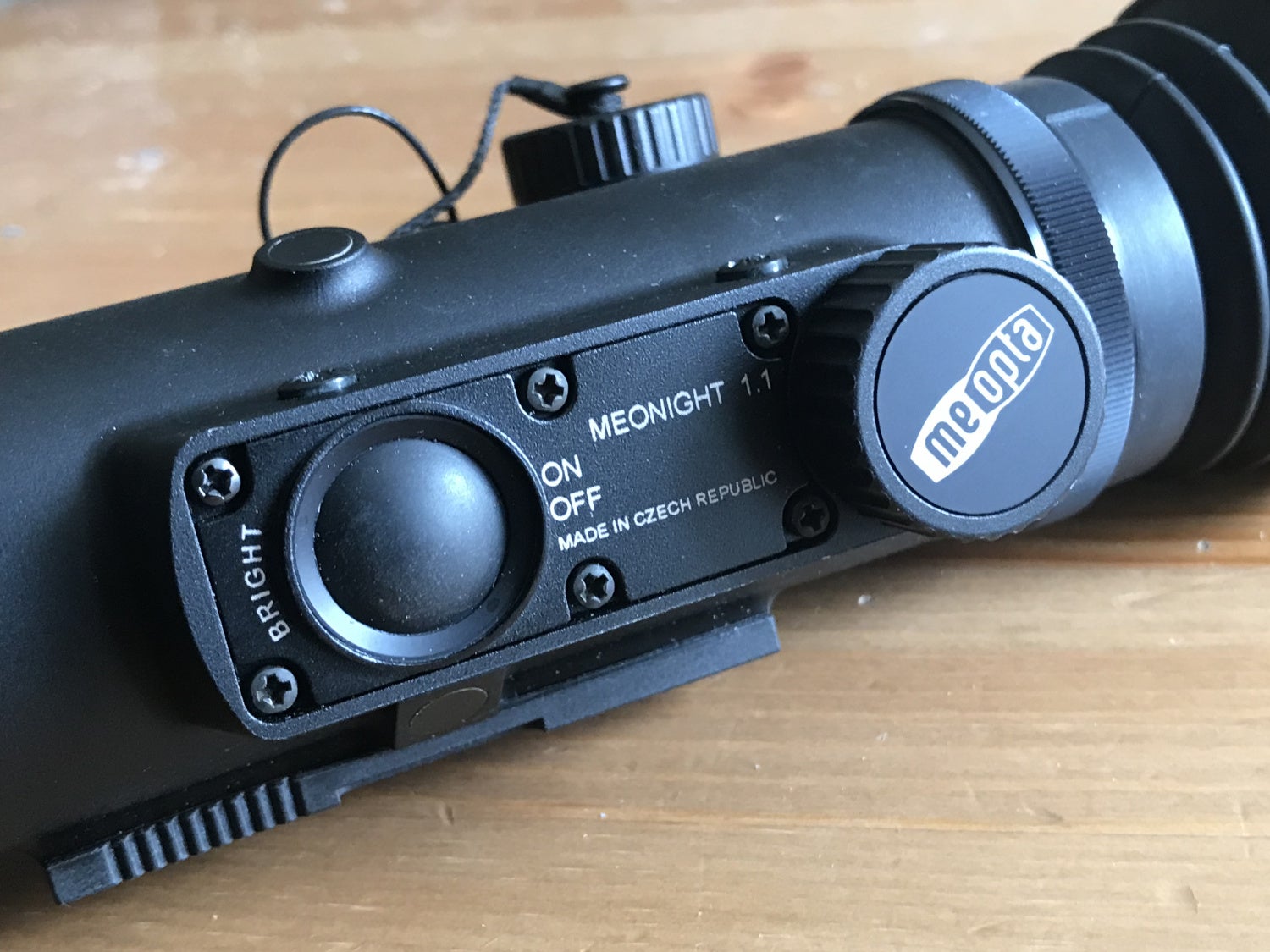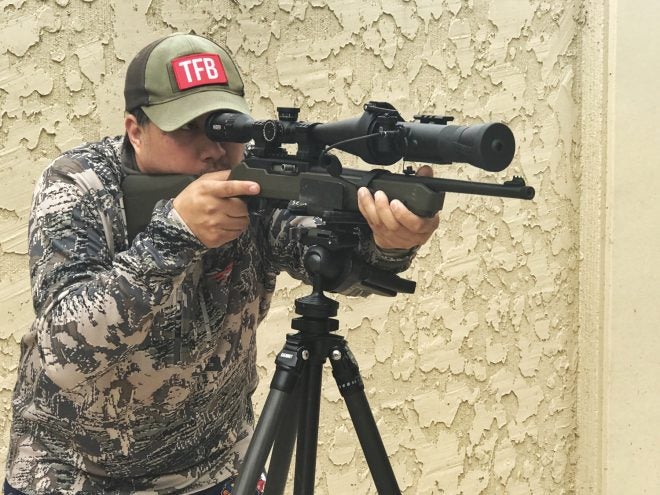For those of you who do not know the Meopta brand, you are missing out. Their optics are made 100% in the Czech Republic. Check out our factory tour back in 2014. Just over a year ago Meopta announced their Meonight 1:1 night vision device. The Meonight clip-on allows you to use a day scope, ideally a Meopta scope, to see in the dark while shooting.
Clip-On Night Vision vs Handheld Or Head Mounted Night Vision
Traditional night vision like the ubiquitous AN/PVS-14 is designed to be worn on the head. These allow you to see in the night but they have their limitations. The aspect is 1:1 just like your normal vision and they are not really designed to be used behind a magnified optic. That is why you see people use lasers or red dots when shooting with helmet-mounted night vision. The other issues is the distance. You can only see so far. PID (positive identification) is officially 178 yards according to TNVC who got that info from the military. You can see further than that but trying to see an animal or target further out is harder.
Handheld night vision devices, in some instances, have some magnification but they are glorified handheld spotting scopes with an intensifier tube. Not terribly useful when trying to aim and shoot at night.
A clip-on night vision device (CNVD) allows you to see through a day optic and you mount the CNVD in front of the day optic. Your day optic is basically looking at a small screen inside the CNVD however when built properly there is very little parallax and little to no POA shift. Since the day optic is looking at a glorified screen, you can only use so much magnification before the image distorts.
Some CNVDs clip onto a long top rail, like the PVS-30. But if your gun does not have a long enough top rail you are kind of out of luck. There are some special scope mounts that have a long rail to suspend a CNVD in front of your scope.
Meonight CNVD

The Meonight has a Picatinny mount but unfortunately, they did not send one in for the review. Instead, they shipped it with a scope objective adapter. The adapter fits the Meostar R1 3-12×56 they sent with the Meonight. The adapter screws onto the eyepiece of the Meonight and you slip the adapter over the objective lens of the Meostar R1. There is a throw lever to clamp the adapter onto the objective lens. The one downside to this attachment method is that it is limited to this specific scope outer diameter.

The Meostar R1 has fantastic light transmission but the reticle is a little too simple for my tastes. I tried using it on my Ruger Precision Rimfire. I was shooting anywhere from 50-300 yards using SK Plus Standard subsonic ammunition and the lack of any subtensions for hold over was rather annoying. I had to guess how high to hold for shooting further distances.

Don’t worry, The gun was not pointed for this photo below. I removed the scope and positioned it in my Pig Saddle on my tripod.

Meostar R1 reticle while looking through the Meonight CNVD
I wanted to use my Meopro 6.5-20×50 scope but the objective bezel is too narrow. While you can buy another adapter for the right size, I just had my friend Brian Miller 3D print me a spacer that would take up the gap between the Meonight CNVD adapter and the Meopro scope.

Meopro reticle has subtensions for holdover.

3D printed shim for Meopro scope.

How Well Does The Meonight CNVD See In The Dark?
When I first tested the Meonight CNVD, there was no moon and the Meonight struggled. I could not see past 300 yards even with a good IR illuminator. I tried it again under a full moon and I was able to see hills out to 1200 yards. Even though I could see that far, higher magnification distorts the image making it difficult to see targets at longer distances.
On the side of the Meonight are the controls. The big round rubber button is the power button as well as gain/brightness control. Press and hold to turn the unit on. Let go then press and hold again to dim the intensifier tube. Once you reach your desired level of brightness just let go. If you keep holding the button down eventually the tube will dim to its lowest setting and the tube will flash letting you know you have reached the lowest brightness. Press and hold again to increase brightness. The tube will flash once you have reached the brightest setting. If you push the button twice the Meonight will turn off.


The knob just behind the power button adjusts the focus of the lenses inside. The whole unit is powered by a CR123. The two screws you see above are for mounting an accessory rail. This is for mounting an IR illuminator or IR laser.


On the other side of the Meonight housing is a port for a pigtail switch. 
I found the tape switch a little useless. It was easier to just reach up with my support thumb to press the power button. But I suppose if you have a rifle setup where the button is out of reach then a tape switch would be useful.

My only concern is that the tape switch plug is rather long and sticks out like a sore thumb. This seems like a potential snag risk. They should have used a 90-degree plug so the cable would end up running closer to the body.

The Meonight CNVD doubles as a handheld 1x night vision monocular. Just remove the adapter and screw on the eyecup and eyecup retaining ring. The rubber cap also doubles as a day time filter so you can safely use the Meonight during the day if you want to check if it is working and in case of accidental activation.

There is a little bit of a drawback to the Meonight as a CNVD and as a handheld monocular. The field of view is rather small compared to the traditional 40 degree FOV you find in PVS-14s and similar helmet mounted NVGs.
See the picture below. I took a photo through my ANVIS9 goggle and the Meonight from the same distance. Then superimposed the Meonight image into the ANVIS9 image. It is a lot smaller. Almost 50% smaller.

Having a Picatinny mount would be better for using it on multiple platforms and various optics. One minor point I have to give to the Meonight is that it can attach to the objective lens of a scope using the clamping adapter. This allows me to attach it to guns that do not have a rail to mount a CNVD. With the right lighting, the Meonight CNVD is useable but the price makes it less desirable. At an MSRP of $4,499, you could get a better CNVD with longer range capabilities. For more information check out their website.
 Your Privacy Choices
Your Privacy Choices
